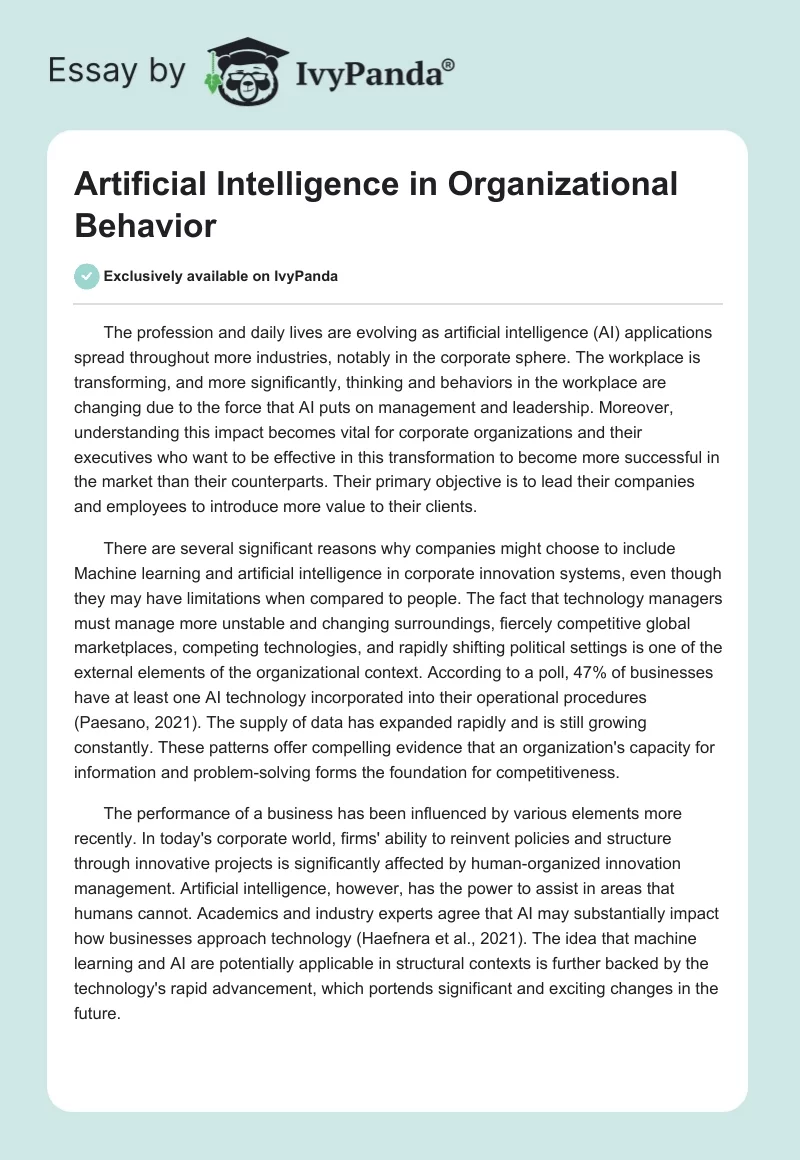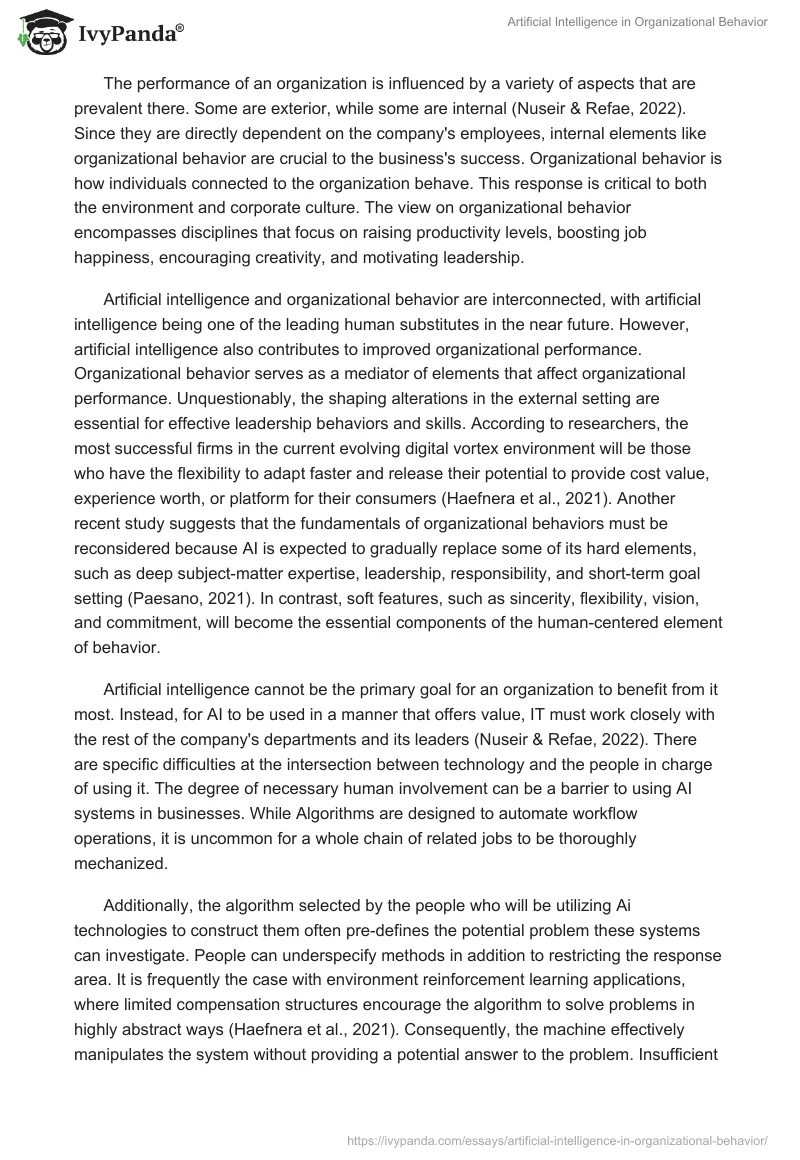The profession and daily lives are evolving as artificial intelligence (AI) applications spread throughout more industries, notably in the corporate sphere. The workplace is transforming, and more significantly, thinking and behaviors in the workplace are changing due to the force that AI puts on management and leadership. Moreover, understanding this impact becomes vital for corporate organizations and their executives who want to be effective in this transformation to become more successful in the market than their counterparts. Their primary objective is to lead their companies and employees to introduce more value to their clients.
There are several significant reasons why companies might choose to include Machine learning and artificial intelligence in corporate innovation systems, even though they may have limitations when compared to people. The fact that technology managers must manage more unstable and changing surroundings, fiercely competitive global marketplaces, competing technologies, and rapidly shifting political settings is one of the external elements of the organizational context. According to a poll, 47% of businesses have at least one AI technology incorporated into their operational procedures (Paesano, 2021). The supply of data has expanded rapidly and is still growing constantly. These patterns offer compelling evidence that an organization’s capacity for information and problem-solving forms the foundation for competitiveness.
The performance of a business has been influenced by various elements more recently. In today’s corporate world, firms’ ability to reinvent policies and structure through innovative projects is significantly affected by human-organized innovation management. Artificial intelligence, however, has the power to assist in areas that humans cannot. Academics and industry experts agree that AI may substantially impact how businesses approach technology (Haefnera et al., 2021). The idea that machine learning and AI are potentially applicable in structural contexts is further backed by the technology’s rapid advancement, which portends significant and exciting changes in the future.
The performance of an organization is influenced by a variety of aspects that are prevalent there. Some are exterior, while some are internal (Nuseir & Refae, 2022). Since they are directly dependent on the company’s employees, internal elements like organizational behavior are crucial to the business’s success. Organizational behavior is how individuals connected to the organization behave. This response is critical to both the environment and corporate culture. The view on organizational behavior encompasses disciplines that focus on raising productivity levels, boosting job happiness, encouraging creativity, and motivating leadership.
Artificial intelligence and organizational behavior are interconnected, with artificial intelligence being one of the leading human substitutes in the near future. However, artificial intelligence also contributes to improved organizational performance. Organizational behavior serves as a mediator of elements that affect organizational performance. Unquestionably, the shaping alterations in the external setting are essential for effective leadership behaviors and skills. According to researchers, the most successful firms in the current evolving digital vortex environment will be those who have the flexibility to adapt faster and release their potential to provide cost value, experience worth, or platform for their consumers (Haefnera et al., 2021). Another recent study suggests that the fundamentals of organizational behaviors must be reconsidered because AI is expected to gradually replace some of its hard elements, such as deep subject-matter expertise, leadership, responsibility, and short-term goal setting (Paesano, 2021). In contrast, soft features, such as sincerity, flexibility, vision, and commitment, will become the essential components of the human-centered element of behavior.
Artificial intelligence cannot be the primary goal for an organization to benefit from it most. Instead, for AI to be used in a manner that offers value, IT must work closely with the rest of the company’s departments and its leaders (Nuseir & Refae, 2022). There are specific difficulties at the intersection between technology and the people in charge of using it. The degree of necessary human involvement can be a barrier to using AI systems in businesses. While Algorithms are designed to automate workflow operations, it is uncommon for a whole chain of related jobs to be thoroughly mechanized.
Additionally, the algorithm selected by the people who will be utilizing Ai technologies to construct them often pre-defines the potential problem these systems can investigate. People can underspecify methods in addition to restricting the response area. It is frequently the case with environment reinforcement learning applications, where limited compensation structures encourage the algorithm to solve problems in highly abstract ways (Haefnera et al., 2021). Consequently, the machine effectively manipulates the system without providing a potential answer to the problem. Insufficient human requirements might potentially provide misleading outcomes in new behavioral algorithms.
Therefore, artificial intelligence has become an essential tool in modern business, which presents many new opportunities for company development. Integrating AI into firms seeking innovative approaches seems to be where AI’s clear potential exists to develop a more structured process. However, the limitations show that AI cannot be isolated and must be integrated into the human-centered organizational behavior pattern to balance the workplace environment. Nevertheless, recent developments in algorithms show that they have the ability to handle more complex problems in strategy implementation.
References
Haefnera, N., Wincentab, J., Paridacde, V. & Gassmann O. (2021). Artificial intelligence and innovation management: A review, framework, and research agenda. Technological Forecasting and Social Change, 162. Web.
Nuseir, M & Refae, G. (2022). The role of artificial intelligence, marketing strategies, and organizational capabilities in organizational performance: The moderating role of organizational behavior. Uncertain Supply Chain Management, 10(4), 1457-1466. Web.
Paesano, A. (2021). Artificial intelligence and creative activities inside organizational behavior, International Journal of Organizational Analysis, 29(3). Web.


